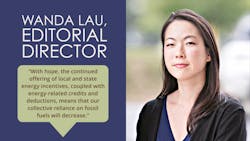COMMENTARY | Financial incentives make energy transition more accessible
Spring has arrived, which at my former residence in Washington, D.C., meant a dramatic drop in electric bills as the rooftop solar panels basked in longer doses of direct, high-angle sunlight. Our use of grid-supplied power would often drop into negative territory through the fall, thanks to net metering.
A solar renewable energy credit program offered by the District, combined with the federal solar investment tax credit, had given us the extra push to install the panels and reduce our reliance on fossil fuels (the local utility sourced only 7% of its electricity from renewables). With hope, the continued offering of local and state energy incentives, coupled with the Inflation Reduction Act’s slew of energy-related credits and deductions for individuals and businesses, means that our collective reliance on fossil fuels will decrease. This trend needs more momentum stat if we have any hope of limiting global warming to 1.5°C (2.7°F) above pre-industrial averages, lest we face the risk of irreparable damage to ecosystems and habitats worldwide.
In March, the U.S. Energy Information Administration delivereda sliver of hope to concerned global citizens with news that electric power generated from renewable sources surpassed that generated from coal last year for the first time. “Renewable energy is now the most affordable source of new electricity in much of the country,” said Gregory Wetstone, president and CEO of the American Council on Renewable Energy, in an Associated Press story.
However, the country’s reliance on the burning of another fossil fuel ticked up. Natural gas was our largest energy source, providing 39% of our power demand in 2022, up from 37% in 2021. Natural gas–fired generation does produce less than half of the carbon dioxide emissions produced in coal-fired generation, but renewables produce zero emissions once their infrastructure is in place.
Back to the “glass is half-full” perspective, we can improve our energy efficiency significantly today. One of the more accessible technologies is, no surprise to our readers, LEDs. By now, we all know LEDs can use up to 90% less energy than incandescent lamps, and up to 80% less energy than fluorescent. Lighting accounts for nearly 20% of global electricity usage, so converting every traditional light source would give our race to zero carbon emissions a boost. Networked lighting controls can further notch down our power demand, with the added benefit of improving the occupant experience.
In this issue, the Lighting Controls Association rounds up outstanding rebates to upgrade lighting and controls that commercial building owners should take advantage of before all installations are expected to be LEDs — and before building codes calculate baseline efficiencies assuming the installation of LEDs. We also visit two landmark projects in the Kansas City region that achieved their ambitious sustainability goals with the help of LEDs.
WANDA LAU is editorial director of LEDs Magazine, Architectural SSL, and Smart Buildings Technology. She previously served as executive editor of Architect magazine and worked for a decade in the architecture, engineering, and construction industry.
For up-to-the-minute LED and SSL updates, follow us on Twitter. You’ll find curated content and commentary, as well as information on industry events, webcasts, and surveys on our LinkedIn page and our Facebook page.

Wanda Lau | Editorial director, LEDs Magazine, Architectural SSL, and Smart Buildings Technology
Wanda Lau is an award-winning editor, writer, and podcaster whose work appears in several publications, including Architectural Lighting and Architect, where she was most recently the executive editor. In 2021, she was named one of Folio: and AdMonsters' Top Women in Media, in the DEI Champions category. Along with working a decade in the architecture, engineering, and construction industry, she holds a B.S. in civil engineering from Michigan State University, an S.M. in building technology from MIT, and an M.A. in journalism from Syracuse University.





![The DesignLights Consortium continues to make progress in shifting outdoor lighting products and implementation practices toward a more restrained and thoughtful strategy. [Image does not represent a DLC qualified fixture.] The DesignLights Consortium continues to make progress in shifting outdoor lighting products and implementation practices toward a more restrained and thoughtful strategy. [Image does not represent a DLC qualified fixture.]](https://img.ledsmagazine.com/files/base/ebm/leds/image/2024/08/66be810888ae93f656446f61-dreamstime_m_265700653.png?auto=format,compress&fit=&q=45&h=139&height=139&w=250&width=250)